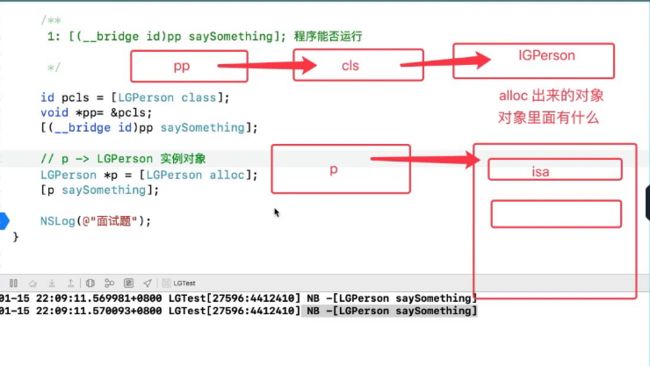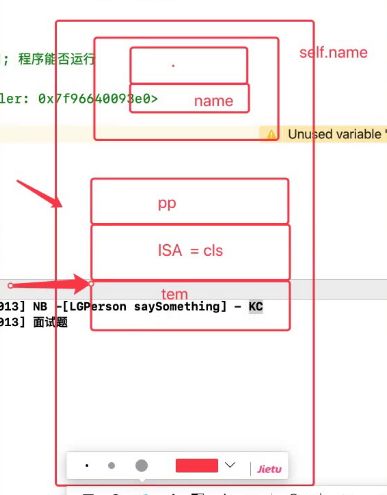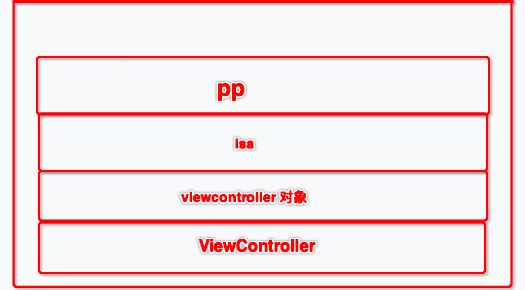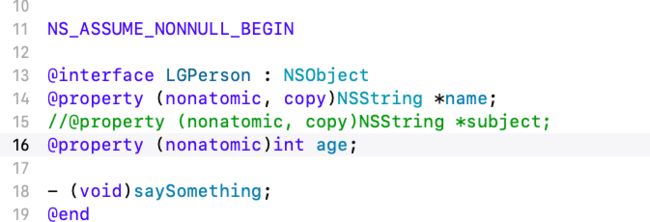iOS -- 经典面试题
iOS -- 经典面试题
- 1. `Runtime` 是什么?
- 2. 方法的本质是什么?SEL是什么?IMP是什么?两者之间的关系是什么?
- 3. 能否向编译后的得到的类中增加实例变量?能否向运行时创建的类添加实例变量?
- 4. isKindOfClass 和 isMemberOfClass 的区别
- 5. [self class] 和 [super class] 的区别
- 6. weak 原理,weak 如何实现,为什么可以自动置为 nil
- 7. __strong 分析
- 8. 对 数组 越界与什么好的处理方法?(Method Swizzling 的使用)
- 9. 内存偏移问题
1. Runtime 是什么?
Runtime是一套有C、C++和汇编混合编写的API,为OC加入了面向对象以及运行时的功能。
运行时是指将数据类型的确定有编译时,推迟到了运行时。
比如:在编译时,只读取macho中的数据到ro,而真正方法的读取是在rw中体现的,编译好的ro是无法修改的,可以通过运行时API给编译好的类可以通过运行时添加方法和属性。
可以通过Runtime API,可以动态的添加属性,交换方法,调用底层发送消息
2. 方法的本质是什么?SEL是什么?IMP是什么?两者之间的关系是什么?
方法的本质是发送消息,发送消息会有一下几个流程
- 快速查找
(objc_msgSend),从cache_t中查找是否有缓存的IMP。 - 慢速查找,递归自己然后父类,
lookUpImpOrForward - 查找不到消息开始动态方法解析,
resolveInstanceMethod - 消息快速转发流程,
forwardingTargetForSelector - 消息慢速转发流程,
methodSignatureForSelector & forwardInvocation
SEL是方法编号,在read_iamges期间,就被编译进了内存中的相关表中
IMP就是我们函数实现的指针,找IMP,就是找函数实现的过程。
就比如:sel相当于书本的目录的标题,IMP就相当于书本的页码,我们首先知道我们想看什么,即SEL,然后根据目录找到对应的页码IMP,然后翻到具体内容的一个过程。
3. 能否向编译后的得到的类中增加实例变量?能否向运行时创建的类添加实例变量?
- 不能向编译后得到的类中添加实例变量,因为我们编译好的实例变量存储在
ro中,一旦编译完成,就无法修改。 - 运行时创建的类还没注册到内存,可以添加实例变量。在动态创建的类添加属性的时候,系统不会生成
setter和getter,要手动添加。 - 编译后的得到的类,我们也要通过
类拓展添加实例变量关联对象,类拓展在编译的时候做为类的一部分直接编译到ro中的, - 也通过
分类添加实例变量,需要用关联对象,本质是实例变量的值在关联哈希表中的存储和读取。
4. isKindOfClass 和 isMemberOfClass 的区别
下面代码怎么打印:
BOOL re1 = [(id)[NSObject class] isKindOfClass:[NSObject class]]; //
BOOL re2 = [(id)[NSObject class] isMemberOfClass:[NSObject class]]; //
BOOL re3 = [(id)[LGPerson class] isKindOfClass:[LGPerson class]]; //
BOOL re4 = [(id)[LGPerson class] isMemberOfClass:[LGPerson class]]; //
NSLog(@" re1 :%hhd\n re2 :%hhd\n re3 :%hhd\n re4 :%hhd\n",re1,re2,re3,re4);
BOOL re5 = [(id)[NSObject alloc] isKindOfClass:[NSObject class]]; //
BOOL re6 = [(id)[NSObject alloc] isMemberOfClass:[NSObject class]]; //
BOOL re7 = [(id)[LGPerson alloc] isKindOfClass:[LGPerson class]]; //
BOOL re8 = [(id)[LGPerson alloc] isMemberOfClass:[LGPerson class]]; //
NSLog(@" re5 :%hhd\n re6 :%hhd\n re7 :%hhd\n re8 :%hhd\n",re5,re6,re7,re8);
打印结果:1 0 0 0 1 1 1 1
isKindOfClass有一个继承递归父类的过程,有更多的容错
isMemberOfClass 直接对比元类和类
5. [self class] 和 [super class] 的区别
[self class]本质就是发送消息objc_msgSend,消息接受者是 self, 方法编号:class。
[super class]本质是objc_msgSendSuper,消息的接收者还是self,
方法编号:class 。只是objc_msgSendSuper 会更快 直接跳过 self 的查找
6. weak 原理,weak 如何实现,为什么可以自动置为 nil
通过汇编查看,当用__weak去修饰一个对象的时候,底层会调用下面的方法:
id objc_initWeak(id *location, id newObj)
{
if (!newObj) {
*location = nil;
return nil;
}
return storeWeak
(location, (objc_object*)newObj);
}
查看
storeWeak方法
static id
storeWeak(id *location, objc_object *newObj)
{
assert(haveOld || haveNew);
if (!haveNew) assert(newObj == nil);
Class previouslyInitializedClass = nil;
id oldObj;
SideTable *oldTable;
SideTable *newTable;
// Acquire locks for old and new values.
// Order by lock address to prevent lock ordering problems.
// Retry if the old value changes underneath us.
retry:
if (haveOld) {
oldObj = *location;
oldTable = &SideTables()[oldObj];
} else {
oldTable = nil;
}
if (haveNew) {
newTable = &SideTables()[newObj];
} else {
newTable = nil;
}
SideTable::lockTwo(oldTable, newTable);
if (haveOld && *location != oldObj) {
SideTable::unlockTwo(oldTable, newTable);
goto retry;
}
// Prevent a deadlock between the weak reference machinery
// and the +initialize machinery by ensuring that no
// weakly-referenced object has an un-+initialized isa.
if (haveNew && newObj) {
Class cls = newObj->getIsa();
if (cls != previouslyInitializedClass &&
!((objc_class *)cls)->isInitialized())
{
SideTable::unlockTwo(oldTable, newTable);
class_initialize(cls, (id)newObj);
// If this class is finished with +initialize then we're good.
// If this class is still running +initialize on this thread
// (i.e. +initialize called storeWeak on an instance of itself)
// then we may proceed but it will appear initializing and
// not yet initialized to the check above.
// Instead set previouslyInitializedClass to recognize it on retry.
previouslyInitializedClass = cls;
goto retry;
}
}
// ✅Clean up old value, if any.
if (haveOld) {
weak_unregister_no_lock(&oldTable->weak_table, oldObj, location);
}
// ✅Assign new value, if any.
if (haveNew) {
newObj = (objc_object *)
weak_register_no_lock(&newTable->weak_table, (id)newObj, location,
crashIfDeallocating);
// weak_register_no_lock returns nil if weak store should be rejected
// Set is-weakly-referenced bit in refcount table.
if (newObj && !newObj->isTaggedPointer()) {
newObj->setWeaklyReferenced_nolock();
}
// Do not set *location anywhere else. That would introduce a race.
*location = (id)newObj;
}
else {
// No new value. The storage is not changed.
}
SideTable::unlockTwo(oldTable, newTable);
return (id)newObj;
}
在这个方法中,看到底层维护了一张散列表SideTable,从SideTable中找到维系的一张weak_table,然后判断新值和旧值。
- 判断有旧值,直接进入
weak_unregister_no_lock,最终在weak_resize方法中
static void weak_resize(weak_table_t *weak_table, size_t new_size)
{
size_t old_size = TABLE_SIZE(weak_table);
weak_entry_t *old_entries = weak_table->weak_entries;
weak_entry_t *new_entries = (weak_entry_t *)
calloc(new_size, sizeof(weak_entry_t));
weak_table->mask = new_size - 1;
weak_table->weak_entries = new_entries;
weak_table->max_hash_displacement = 0;
weak_table->num_entries = 0; // restored by weak_entry_insert below
if (old_entries) {
weak_entry_t *entry;
weak_entry_t *end = old_entries + old_size;
for (entry = old_entries; entry < end; entry++) {
if (entry->referent) {
//✅ entry加入到我们的weak_table
weak_entry_insert(weak_table, entry);
}
}
free(old_entries);
}
}
通过
weak_entry_insert(weak_table, entry)将修饰的对象,插入到eak_table中。
- 判断有新值,进入
weak_register_no_lock,
/**
* Registers a new (object, weak pointer) pair. Creates a new weak
* object entry if it does not exist.
*
* @param weak_table The global weak table.
* @param referent The object pointed to by the weak reference.
* @param referrer The weak pointer address.
*/
id
weak_register_no_lock(weak_table_t *weak_table, id referent_id,
id *referrer_id, bool crashIfDeallocating)
{
objc_object *referent = (objc_object *)referent_id;
objc_object **referrer = (objc_object **)referrer_id;
if (!referent || referent->isTaggedPointer()) return referent_id;
// ensure that the referenced object is viable
bool deallocating;
if (!referent->ISA()->hasCustomRR()) {
deallocating = referent->rootIsDeallocating();
}
else {
BOOL (*allowsWeakReference)(objc_object *, SEL) =
(BOOL(*)(objc_object *, SEL))
object_getMethodImplementation((id)referent,
SEL_allowsWeakReference);
if ((IMP)allowsWeakReference == _objc_msgForward) {
return nil;
}
deallocating =
! (*allowsWeakReference)(referent, SEL_allowsWeakReference);
}
if (deallocating) {
if (crashIfDeallocating) {
_objc_fatal("Cannot form weak reference to instance (%p) of "
"class %s. It is possible that this object was "
"over-released, or is in the process of deallocation.",
(void*)referent, object_getClassName((id)referent));
} else {
return nil;
}
}
// now remember it and where it is being stored
weak_entry_t *entry;
// ✅根据referent 找到 entyry
if ((entry = weak_entry_for_referent(weak_table, referent))) {
append_referrer(entry, referrer);
}
else {
// ✅创建了这个数组 - 插入weak_table
weak_entry_t new_entry(referent, referrer);
weak_grow_maybe(weak_table);
weak_entry_insert(weak_table, &new_entry);
}
// Do not set *referrer. objc_storeWeak() requires that the
// value not change.
return referent_id;
}
通过referent从 weak_table中,找到entry,判断entry
是否存在(entry = weak_entry_for_referent(weak_table, referent))),存在append_referrer,将其添加到entry中,不存在,则创建一个weak_entry_t,然后四分之三扩容,然后插入到new_entry中(weak_entry_insert(weak_table, &new_entry))。
总结:
__weak底层维系一张散列表SideTable,SideTable中维系一张弱引用表weak_table,在这张弱引用表中,有很多弱引用对象的实体weak_entry_t *entry。
__weak就是根据传进来的弱引用对象,去weak_table中找到对应的实体weak_entry_t *entry,然后检查是否需要扩容(3/4扩容),然后拼接进行内部持有(new_referrers[i] = entry->inline_referrers[i])的过程,如果这个entry不存在,则创建一下新的实体entry,然后扩容,再插入weak_entry_insert
那么,
__weak为什么可以自动置为nil?
查看dealloc源码,最终在objc_destructInstance方法中,如下源码:
void *objc_destructInstance(id obj)
{
if (obj) {
// Read all of the flags at once for performance.
bool cxx = obj->hasCxxDtor();
// ✅关联对象表
bool assoc = obj->hasAssociatedObjects();
// This order is important.
if (cxx) object_cxxDestruct(obj);
// ✅移除关联对象表
if (assoc) _object_remove_assocations(obj);
obj->clearDeallocating();
}
return obj;
}
进入obj->clearDeallocating()方法
inline void
objc_object::clearDeallocating()
{
if (slowpath(!isa.nonpointer)) {
// Slow path for raw pointer isa.
sidetable_clearDeallocating();
}
else if (slowpath(isa.weakly_referenced || isa.has_sidetable_rc)) {
// Slow path for non-pointer isa with weak refs and/or side table data.
clearDeallocating_slow();
}
assert(!sidetable_present());
}
在clearDeallocating经过判断,最终都会进入到weak_clear_no_lock方法中,
void
weak_clear_no_lock(weak_table_t *weak_table, id referent_id)
{
objc_object *referent = (objc_object *)referent_id;
weak_entry_t *entry = weak_entry_for_referent(weak_table, referent);
if (entry == nil) {
/// XXX shouldn't happen, but does with mismatched CF/objc
//printf("XXX no entry for clear deallocating %p\n", referent);
return;
}
// zero out references
weak_referrer_t *referrers;
size_t count;
if (entry->out_of_line()) {
referrers = entry->referrers;
count = TABLE_SIZE(entry);
}
else {
referrers = entry->inline_referrers;
count = WEAK_INLINE_COUNT;
}
for (size_t i = 0; i < count; ++i) {
objc_object **referrer = referrers[i];
if (referrer) {
if (*referrer == referent) {
*referrer = nil;
}
else if (*referrer) {
_objc_inform("__weak variable at %p holds %p instead of %p. "
"This is probably incorrect use of "
"objc_storeWeak() and objc_loadWeak(). "
"Break on objc_weak_error to debug.\n",
referrer, (void*)*referrer, (void*)referent);
objc_weak_error();
}
}
}
weak_entry_remove(weak_table, entry);
}
在weak_clear_no_lock中直接将关联对象的指针referrer置为nil,所以当其释放时,会自动设置为空。
7. __strong 分析
跟__weak一样,先通过汇编分析,找到底层调用的objc_storeStrong方法,如下:
void
objc_storeStrong(id *location, id obj)
{
id prev = *location;
if (obj == prev) {
return;
}
objc_retain(obj);
*location = obj;
objc_release(prev);
}
先objc_retain(obj),在objc_release(prev),而objc_retain方法和objc_release方法底层都是发送retain和release消息。
8. 对 数组 越界与什么好的处理方法?(Method Swizzling 的使用)
在处理数组越界的时候,我们很容易想到的就是通过Runtime进行方法交换。
我们通常会创建一个分类,如下:
#import "NSArray+LG.h"
#import "LGRuntimeTool.h"
#import
@implementation NSArray (LG)
+ (void)load{
[LGRuntimeTool lg_methodSwizzlingWithClass:objc_getClass("__NSArrayI") oriSEL:@selector(objectAtIndex:) swizzledSEL:@selector(lg_objectAtIndex:)];
[LGRuntimeTool lg_methodSwizzlingWithClass:objc_getClass("__NSArrayI") oriSEL:@selector(objectAtIndexedSubscript:) swizzledSEL:@selector(lg_objectAtIndexedSubscript:)];
}
// 交换的方法
- (id)lg_objectAtIndex:(NSUInteger)index{
if (index > self.count-1) {
NSLog(@"数组越界 -- ");
NSLog(@"取值越界了,记录:%lu > %lu", (unsigned long)index, self.count - 1);
return nil;
}
return [self lg_objectAtIndex:index];
}
- (id)lg_objectAtIndexedSubscript:(NSUInteger)index {
if (index > self.count-1) {
NSLog(@"数组越界 -- ");
NSLog(@"取值越界了,记录:%lu > %lu", (unsigned long)index, self.count - 1);
return nil;
}
return [self lg_objectAtIndexedSubscript:index];
}
#import "LGRuntimeTool.h"
#import
@implementation LGRuntimeTool
+ (void)lg_methodSwizzlingWithClass:(Class)cls oriSEL:(SEL)oriSEL swizzledSEL:(SEL)swizzledSEL{
if (!cls) NSLog(@"传入的交换类不能为空");
Method oriMethod = class_getInstanceMethod(cls, oriSEL);
Method swiMethod = class_getInstanceMethod(cls, swizzledSEL);
method_exchangeImplementations(oriMethod, swiMethod);
}
@end
对objectAtIndex和lg_objectAtIndex进行交换,当调用系统objectAtIndex方法时,调用lg_objectAtIndex方法,方便我们在数组越界时的一些处理(比如防崩溃)
那么假如我们在添加了NSArray的分类之后,在某个调用的地方,不小心调用了,NSArray的load方法,比如下面的代码,会发生什么呢?
self.dataArray = @[@"Hank",@"Cooci",@"Kody",@"CC"];
[NSArray load];
NSLog(@"%@",[self.dataArray objectAtIndex:4]);
通过验证,上面的代码,会崩溃,当再次调用load方法时,会再次交换方法,调用系统的objectAtIndex方法,而导致崩溃。
所以,我们要在添加分类的load方法中,使用单例,防止方法多次重复交换
+ (void)load{
static dispatch_once_t onceToken;
dispatch_once(&onceToken, ^{
[LGRuntimeTool lg_methodSwizzlingWithClass:objc_getClass("__NSArrayI") oriSEL:@selector(objectAtIndex:) swizzledSEL:@selector(lg_objectAtIndex:)];
[LGRuntimeTool lg_methodSwizzlingWithClass:objc_getClass("__NSArrayI") oriSEL:@selector(objectAtIndexedSubscript:) swizzledSEL:@selector(lg_objectAtIndexedSubscript:)];
});
}
那么在日常的开发中,经常出现继承关系,而在这个继承关系中,经常出现子类继承父类的方法,那么在子类中交换继承自父类的方法会出现什么情况呢?如下代码:
// 父类
@interface LGPerson : NSObject
- (void)personInstanceMethod;
+ (void)personClassMethod;
@end
#import "LGPerson.h"
@implementation LGPerson
- (void)personInstanceMethod{
NSLog(@"person对象方法:%s",__func__);
}
+ (void)personClassMethod{
NSLog(@"person类方法:%s",__func__);
}
@end
// 子类
@interface LGStudent : LGPerson
@end
#import "LGStudent.h"
@implementation LGStudent
@end
上面代码中LGStudent继承自LGPerson,而LGPerson中实现了personInstanceMethod和personClassMethod两个方法,
在子类LGStudent中,对personInstanceMethod方法进行方法交换,如下:
@implementation LGStudent (LG)
+ (void)load{
static dispatch_once_t onceToken;
dispatch_once(&onceToken, ^{
[LGRuntimeTool lg_methodSwizzlingWithClass:self oriSEL:@selector(personInstanceMethod) swizzledSEL:@selector(lg_studentInstanceMethod)];
});
}
- (void)lg_studentInstanceMethod{
[self lg_studentInstanceMethod];
NSLog(@"LGStudent分类添加的lg对象方法:%s",__func__);
}
@end
+ (void)lg_methodSwizzlingWithClass:(Class)cls oriSEL:(SEL)oriSEL swizzledSEL:(SEL)swizzledSEL{
if (!cls) NSLog(@"传入的交换类不能为空");
Method oriMethod = class_getInstanceMethod(cls, oriSEL);
Method swiMethod = class_getInstanceMethod(cls, swizzledSEL);
method_exchangeImplementations(oriMethod, swiMethod);
}
这样的方法交换,在我们调用LGStudent的时候,完美的实现了方法互换,那么在我们调用父类LGPerson时,会有什么问题呢?调用如下:
LGStudent *s = [[LGStudent alloc] init];
[s personInstanceMethod];
LGPerson *p = [[LGPerson alloc] init];
[p personInstanceMethod];
结果如下:

在运行结果中看到,在父类调用personInstanceMethod时,出现了父类调用lg_studentInstanceMethod,而父类本身没有这个方法,所以就崩溃了。
那么,子类在交换继承自父类而自己本身没有重写的方法时,应该怎么做呢 ?
其实,我们可以在方法交换的时候做一个判断,先尝试添加一个方法,
+ (void)lg_betterMethodSwizzlingWithClass:(Class)cls oriSEL:(SEL)oriSEL swizzledSEL:(SEL)swizzledSEL{
if (!cls) NSLog(@"传入的交换类不能为空");
// oriSEL personInstanceMethod
// swizzledSEL lg_studentInstanceMethod
Method oriMethod = class_getInstanceMethod(cls, oriSEL);
Method swiMethod = class_getInstanceMethod(cls, swizzledSEL);
// 尝试添加
// ✅ 首先第一步:会先尝试给自己添加要交换的方法 :personInstanceMethod (SEL) -> swiMethod(IMP)
BOOL success = class_addMethod(cls, oriSEL, method_getImplementation(swiMethod), method_getTypeEncoding(oriMethod));
/**
personInstanceMethod(sel) - lg_studentInstanceMethod(imp)
lg_studentInstanceMethod (swizzledSEL) - personInstanceMethod(imp)
*/
//oriSEL:personInstanceMethod
if (success) {// 自己没有 - 交换 - 没有父类进行处理 (重写一个)
// ✅ 然后再将父类的IMP给swizzle personInstanceMethod(imp) -> swizzledSEL
class_replaceMethod(cls, swizzledSEL, method_getImplementation(oriMethod), method_getTypeEncoding(oriMethod));
}else{ // 自己有
method_exchangeImplementations(oriMethod, swiMethod);
}
}
这样就可以完美的对子类的方法进行交换了,调用结果如下,
那么,还有一个问题,假如某人交换了只有声明并没有实现的方法,上面的方式就会出现死循环,因为根本没有父类方法的IMP,所以,还要对其进行改造。
代码如下:
+ (void)lg_bestMethodSwizzlingWithClass:(Class)cls oriSEL:(SEL)oriSEL swizzledSEL:(SEL)swizzledSEL{
if (!cls) NSLog(@"传入的交换类不能为空");
Method oriMethod = class_getInstanceMethod(cls, oriSEL);
Method swiMethod = class_getInstanceMethod(cls, swizzledSEL);
if (!oriMethod) {
// 在oriMethod为nil时,替换后将swizzledSEL复制一个不做任何事的空实现,代码如下:
class_addMethod(cls, oriSEL, method_getImplementation(swiMethod), method_getTypeEncoding(swiMethod));
method_setImplementation(swiMethod, imp_implementationWithBlock(^(id self, SEL _cmd){ }));
}
// 一般交换方法: 交换自己有的方法 -- 走下面 因为自己有意味添加方法失败
// 交换自己没有实现的方法:
// 首先第一步:会先尝试给自己添加要交换的方法 :personInstanceMethod (SEL) -> swiMethod(IMP)
// 然后再将父类的IMP给swizzle personInstanceMethod(imp) -> swizzledSEL
//oriSEL:personInstanceMethod
BOOL didAddMethod = class_addMethod(cls, oriSEL, method_getImplementation(swiMethod), method_getTypeEncoding(swiMethod));
if (didAddMethod) {
class_replaceMethod(cls, swizzledSEL, method_getImplementation(oriMethod), method_getTypeEncoding(oriMethod));
}else{
method_exchangeImplementations(oriMethod, swiMethod);
}
}
在方法交换的时候,先对被交换方法进行判断,判断这个方法是否实现,当方法未实现时,我们手动添加一个空的方法实现,在这个空的方法实现中,我们可以做一些上传等操作,来记录收集crash。
9. 内存偏移问题
- 如下代码,能否正常运行?
@interface LGPerson : NSObject
@property (nonatomic, copy)NSString *name;
@property (nonatomic, copy)NSString *subject;
@property (nonatomic)int age;
- (void)saySomething;
@end
@implementation LGPerson
- (void)saySomething{
NSLog(@"NB %s ",__func__);
}
@end
#import "ViewController.h"
#import
#import "LGPerson.h"
@interface ViewController ()
@end
@implementation ViewController
- (void)viewDidLoad {
[super viewDidLoad];
// NSString *tem = @"KC";
id pcls = [LGPerson class];
void *pp= &pcls;
[(__bridge id)pp saySomething];
// p -> LGPerson 实例对象
LGPerson *p = [LGPerson alloc];
[p saySomething];
}
首先,指针p指向的是LGPerson的实例对象的存储空间,而指针pcls指向的是LGPerson类对象的存储空间。pp指向的是指针pcls的空间,而实例对象中的isa也指向指针pcls,所以pp能够正常调用saySomething方法
- 对
saySomething方法进行修改,如下,并打印self.name。
- (void)saySomething{
NSLog(@"NB %s - %@",__func__,self.name);
}
通过调试,打印结果如下:
那么为什么会打印// NSString *tem = @"KC"注释打开,再来看一下,这一次打印的是KC。
那么为什么会这样呢?
因为栈的内存是连续的,而我们的属性的读取是通过指针偏移来读取的,而压栈的示意如下:
上图中pp指向的是isa,在通过指针偏移读取self.name时,刚好读取到了tem,所以打印了KC,所以当没有打开注释时,打印的是ViewController
接着在saySomething中打印subject,打印出的是ViewController

那么我们接着再添加属性
@property (nonatomic)NSString *age;
打印的话,就会出现野指针报错
或者将age的类型改成int,也会因为读取不到内存,而报错。













